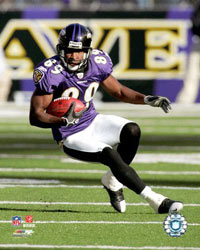Charm the Snake
08/10/2007
Sports Channel / Bullz-Eye Home
 Most fantasy football drafts utilize a “snake” draft where teams pick 1-12 in odd rounds and 12-1 in even rounds. Crafty owners can take advantage of the characteristics of such a draft if their draft position is one, two or three spots from either end. So those owners with the #2, #3, #4, #9, #10 or #11 picks (in a 12-team draft) should pay attention.
Most fantasy football drafts utilize a “snake” draft where teams pick 1-12 in odd rounds and 12-1 in even rounds. Crafty owners can take advantage of the characteristics of such a draft if their draft position is one, two or three spots from either end. So those owners with the #2, #3, #4, #9, #10 or #11 picks (in a 12-team draft) should pay attention.
Here’s the situation: you have the #3 pick in the draft and the two owners ahead of you select LaDainian Tomlinson and Steven Jackson in the first round. You take a running back – let’s say Larry Johnson – and the draft proceeds. Now you’re up again with the 2.10 (#22) pick and you’ve narrowed your pick to the following list:
Clinton Portis, Thomas Jones, Cedric Benson, Reggie Wayne (right) and Larry Fitzgerald
Let’s say that you like Fitzgerald, but are a little worried about how he’ll do with the Cardinals’ new run-first offense. You like Wayne a little more; he’s an up-and-coming WR in a terrific offense. However, you know that RBs are important and you want to select one of the three to round out your backfield, but you can’t decide which one. What do you do?
Take Wayne.
Why?
The two owners picking #1 and #2 each have two picks before your next pick. Both have already taken a RB, so it isn’t likely that either owner is going to select two RBs with the next two picks because they’ll probably want to start filling out the rest of their roster. That leaves you with at least one of the three RBs to pick at 3.03. By selecting Wayne (whom you value more than the next WR, Fitzgerald) you get the best WR on the board while also getting a solid #2 RB in the next round. Since it didn’t matter to you which RB of the three you got, you let the other two owners make the tough decision, while you laugh all the way to the playoffs.
 Now let’s say you’re in the same draft slot and your pick is up at 6.10. So far you’ve selected the following players:
Now let’s say you’re in the same draft slot and your pick is up at 6.10. So far you’ve selected the following players:
Johnson (RB), Wayne (WR), T. Jones (RB), Plaxico Burress (WR), Tony Gonzalez (TE)
Not a bad squad, but you have no QB. At 6.10, you’re selecting from the following group:
Vince Young, Tony Romo, Mark Clayton (right), Joey Galloway, Darrell Jackson
You notice that the team selecting #2 doesn’t yet have a QB while the team selecting #1 has Marc Bulger. You can safely assume that team #1 won’t select another QB so soon, but team #2 might select their first QB before you pick at 7.03. You like both Young and Romo, but you really like Clayton over the other available WRs. In this case, you take Clayton and pass on Young and Romo as one of them will probably be available for you to pick at 7.03.
This principle is applicable to all positions. Whether it’s a TE in the middle rounds or a kicker or a defense in the late rounds, being able to predict your opponents’ actions gives you an advantage during the draft. The key to this strategy is to know what players the #1 and #2 teams have already drafted so you can use that information to your advantage. In live drafts, it is often difficult to draft your own team as well as keep track of the other teams, but if you only pay attention to the important teams – in this case the teams picking #1 and #2 – it shouldn’t be much of a burden.





